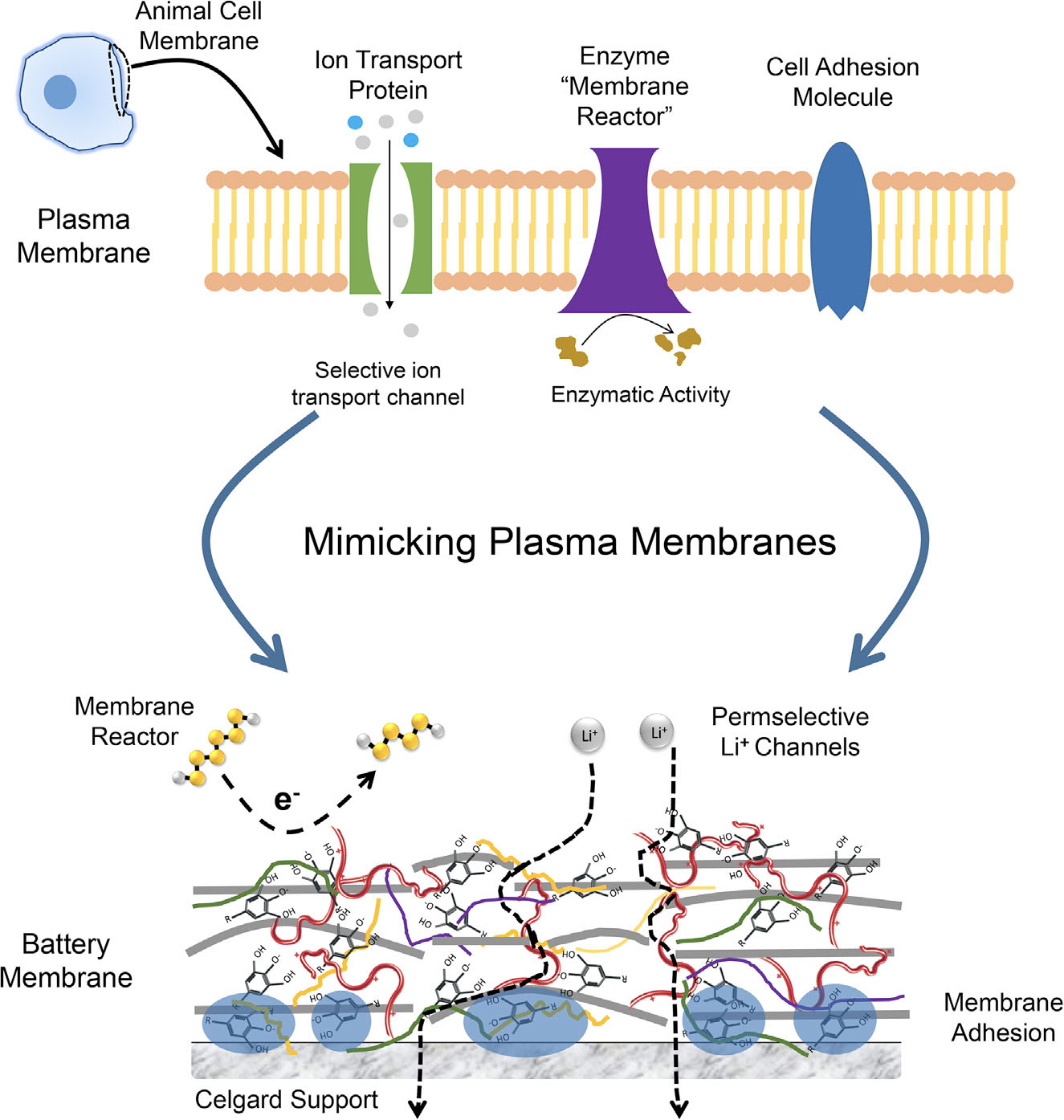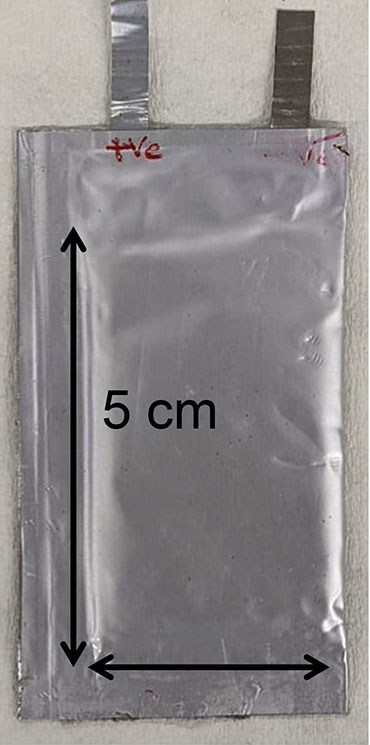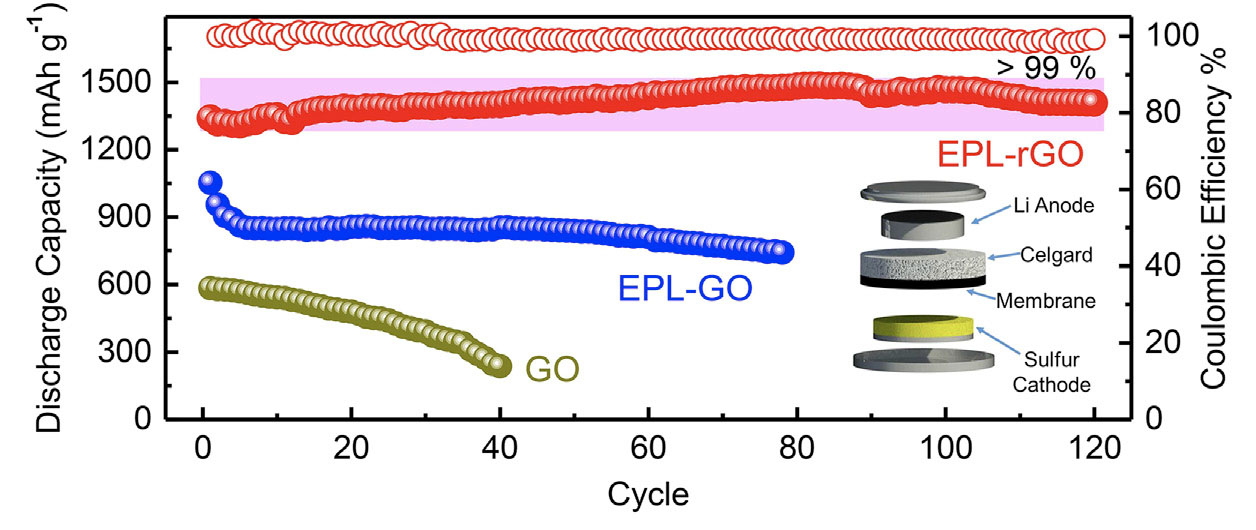Dec 16, 2022
(Nanowerk Spotlight) Lithium-sulfur (Li-S) batteries are compelling candidates for next-generation energy storage devices – sulfur is abundant, low-cost and sustainable. Thanks to the multi-step reactions of sulfur, it also has a greater theoretical energy density than found in current Li-ion battery technology. However, the reaction intermediates, called polysulfides, exhibit poor reaction kinetics and tend to dissolve in the electrolyte. What’s more, they deposit on the surface and passivate all battery components, especially the separator and anode, thereby 'killing' the battery.
Consequently, the ability to regulate complex polysulfide chemistry is a critical challenge in achieving a practical lithium-sulfur battery with high cycle life and minimal electrolyte weight.
"The holy grail in battery research is to improve reaction kinetics and maximize energy density," Petar Jovanović, a researcher in Monash University's Department of Mechanical & Aerospace Engineering, tells Nanowerk. "It is an ongoing battle. In Li-S batteries, the key is to enhance the sluggish reaction kinetics and prevent the soluble polysulfides from leaking out of the cathode. But this has to be done extremely efficiently."
By mimicking a biological cell plasma membrane, i.e. the membrane that separates the interior of the cell from the outside environment and regulates the transport of materials entering and exiting the cell, Jovanović and his co-researchers have demonstrated that a 2D reduced graphene oxide membrane can regulate these polysulfides. They exploit the excellent monovalent Li+ transport properties of a unique elastic polymer liquid (EPL) to construct a composite laminar rGO-based membrane, called EPL-rGO.
 Schematic depicting the analogy between a plasma membrane and the EPL-rGO membrane. (Reprinted from doi:10.1016/j.xcrp.2022.101186 under a CC BY-NC-ND 4.0 license)
The efficiency of this separator in controlling the polysulfide chemistry and its sub-micron thickness allows to minimize the amount of electrolyte needed, which enables lightweight, high energy density batteries.
"This allowed us to make more realistic batteries, demonstrating excellent performance even at high cycling rates," Jovanović, first author of a paper on this work, notes. "We also manufactured prototype pouch cells, ranked among the longest-life Li-S pouches in the literature."
The team reported their findings in Cell Reports Physical Science ("Mimicking a cell plasma membrane to regulate dynamic polysulfide chemistry for a practical lithium-sulfur battery").
Schematic depicting the analogy between a plasma membrane and the EPL-rGO membrane. (Reprinted from doi:10.1016/j.xcrp.2022.101186 under a CC BY-NC-ND 4.0 license)
The efficiency of this separator in controlling the polysulfide chemistry and its sub-micron thickness allows to minimize the amount of electrolyte needed, which enables lightweight, high energy density batteries.
"This allowed us to make more realistic batteries, demonstrating excellent performance even at high cycling rates," Jovanović, first author of a paper on this work, notes. "We also manufactured prototype pouch cells, ranked among the longest-life Li-S pouches in the literature."
The team reported their findings in Cell Reports Physical Science ("Mimicking a cell plasma membrane to regulate dynamic polysulfide chemistry for a practical lithium-sulfur battery").
 Double-sided cathode pouch cell (5 × 3 cm). (Reprinted from doi:10.1016/j.xcrp.2022.101186 under a CC BY-NC-ND 4.0 license)
Dr Mahdokht Shaibani, a co-author on this work, adds: "As far as we can ascertain, our work demonstrates the first reported lithium-sulfur pouch cell employing permselective membranes, indicating the tremendous efforts required to design this critical component of the lithium-sulfur battery at large scales and in a reliable fashion."
So far, permselective membranes have been explored in the literature at largely impractical parameters: very low active materials loadings and high electrolyte volumes means these batteries have only ever demonstrated low energy densities. The main reason for that is that the Li+ ion transport is severely limited, meaning the reactions are slow, and the polysulfides tend to accumulate on the membrane surface.
By increasing the transport rate of Li+ ions with lithiophilic coordination sites, and keeping the membrane surface electrochemically active to polysulfides, the team succeeded in drastically decreasing electrolyte volumes and increasing the sulfur loading.
As a result, by imparting ion-selective channels, enzymatic activity and adhesion properties, the team's EPL-rGO membrane can speed up the transport of desired ions (Li+) while blocking others (polysulfides) and enzymatically breaking them down – i.e., act as a redox mediator. The bio-adhesion offered by incorporating proteins also allows for a stable membrane to be coated onto the 250 nm thick separator.
Double-sided cathode pouch cell (5 × 3 cm). (Reprinted from doi:10.1016/j.xcrp.2022.101186 under a CC BY-NC-ND 4.0 license)
Dr Mahdokht Shaibani, a co-author on this work, adds: "As far as we can ascertain, our work demonstrates the first reported lithium-sulfur pouch cell employing permselective membranes, indicating the tremendous efforts required to design this critical component of the lithium-sulfur battery at large scales and in a reliable fashion."
So far, permselective membranes have been explored in the literature at largely impractical parameters: very low active materials loadings and high electrolyte volumes means these batteries have only ever demonstrated low energy densities. The main reason for that is that the Li+ ion transport is severely limited, meaning the reactions are slow, and the polysulfides tend to accumulate on the membrane surface.
By increasing the transport rate of Li+ ions with lithiophilic coordination sites, and keeping the membrane surface electrochemically active to polysulfides, the team succeeded in drastically decreasing electrolyte volumes and increasing the sulfur loading.
As a result, by imparting ion-selective channels, enzymatic activity and adhesion properties, the team's EPL-rGO membrane can speed up the transport of desired ions (Li+) while blocking others (polysulfides) and enzymatically breaking them down – i.e., act as a redox mediator. The bio-adhesion offered by incorporating proteins also allows for a stable membrane to be coated onto the 250 nm thick separator.
 Comparing permselective membrane separators across coin cells assembled with a sulfur loading of 3.2 mg cm-2. (Reprinted from doi:10.1016/j.xcrp.2022.101186 under a CC BY-NC-ND 4.0 license)
The superior performance of this novel membrane manages to attain excellent capacity and long cycle life while maintaining the challenging electrolyte volume relative to capacity (E/C ratio) of ≤5 µL mAh-1, thereby outperforming a vast majority of the best-in-class Li-S batteries in literature.
Furthermore, the design approach of a reactive permselective membrane can be widely applied to a host of 2D materials and bio-polymers, opening up opportunities for future developments to further tune and control nanochannels, improve reaction kinetics, and extend the cycle life of sulfur-based batteries.
"We are excited because the ion-selectivity of our membranes also gives them potential to be used in flow battery applications – e.g., vanadium flow batteries – and other separation processes such as water purification," Jovanović points out.
He adds that the scalability, reliability and low cost of the manufacturing process means that the membrane is ready to be trialled and optimized further at a pouch cell level. In addition, the advantage of this membrane design means that it is possible to investigate different 2D materials and bio-polymers to improve performance even further.
By
Michael is author of three books by the Royal Society of Chemistry:
Nano-Society: Pushing the Boundaries of Technology,
Nanotechnology: The Future is Tiny, and
Nanoengineering: The Skills and Tools Making Technology Invisible
Copyright ©
Nanowerk
Comparing permselective membrane separators across coin cells assembled with a sulfur loading of 3.2 mg cm-2. (Reprinted from doi:10.1016/j.xcrp.2022.101186 under a CC BY-NC-ND 4.0 license)
The superior performance of this novel membrane manages to attain excellent capacity and long cycle life while maintaining the challenging electrolyte volume relative to capacity (E/C ratio) of ≤5 µL mAh-1, thereby outperforming a vast majority of the best-in-class Li-S batteries in literature.
Furthermore, the design approach of a reactive permselective membrane can be widely applied to a host of 2D materials and bio-polymers, opening up opportunities for future developments to further tune and control nanochannels, improve reaction kinetics, and extend the cycle life of sulfur-based batteries.
"We are excited because the ion-selectivity of our membranes also gives them potential to be used in flow battery applications – e.g., vanadium flow batteries – and other separation processes such as water purification," Jovanović points out.
He adds that the scalability, reliability and low cost of the manufacturing process means that the membrane is ready to be trialled and optimized further at a pouch cell level. In addition, the advantage of this membrane design means that it is possible to investigate different 2D materials and bio-polymers to improve performance even further.
By
Michael is author of three books by the Royal Society of Chemistry:
Nano-Society: Pushing the Boundaries of Technology,
Nanotechnology: The Future is Tiny, and
Nanoengineering: The Skills and Tools Making Technology Invisible
Copyright ©
Nanowerk
 Schematic depicting the analogy between a plasma membrane and the EPL-rGO membrane. (Reprinted from doi:10.1016/j.xcrp.2022.101186 under a CC BY-NC-ND 4.0 license)
The efficiency of this separator in controlling the polysulfide chemistry and its sub-micron thickness allows to minimize the amount of electrolyte needed, which enables lightweight, high energy density batteries.
"This allowed us to make more realistic batteries, demonstrating excellent performance even at high cycling rates," Jovanović, first author of a paper on this work, notes. "We also manufactured prototype pouch cells, ranked among the longest-life Li-S pouches in the literature."
The team reported their findings in Cell Reports Physical Science ("Mimicking a cell plasma membrane to regulate dynamic polysulfide chemistry for a practical lithium-sulfur battery").
Schematic depicting the analogy between a plasma membrane and the EPL-rGO membrane. (Reprinted from doi:10.1016/j.xcrp.2022.101186 under a CC BY-NC-ND 4.0 license)
The efficiency of this separator in controlling the polysulfide chemistry and its sub-micron thickness allows to minimize the amount of electrolyte needed, which enables lightweight, high energy density batteries.
"This allowed us to make more realistic batteries, demonstrating excellent performance even at high cycling rates," Jovanović, first author of a paper on this work, notes. "We also manufactured prototype pouch cells, ranked among the longest-life Li-S pouches in the literature."
The team reported their findings in Cell Reports Physical Science ("Mimicking a cell plasma membrane to regulate dynamic polysulfide chemistry for a practical lithium-sulfur battery").
 Double-sided cathode pouch cell (5 × 3 cm). (Reprinted from doi:10.1016/j.xcrp.2022.101186 under a CC BY-NC-ND 4.0 license)
Dr Mahdokht Shaibani, a co-author on this work, adds: "As far as we can ascertain, our work demonstrates the first reported lithium-sulfur pouch cell employing permselective membranes, indicating the tremendous efforts required to design this critical component of the lithium-sulfur battery at large scales and in a reliable fashion."
So far, permselective membranes have been explored in the literature at largely impractical parameters: very low active materials loadings and high electrolyte volumes means these batteries have only ever demonstrated low energy densities. The main reason for that is that the Li+ ion transport is severely limited, meaning the reactions are slow, and the polysulfides tend to accumulate on the membrane surface.
By increasing the transport rate of Li+ ions with lithiophilic coordination sites, and keeping the membrane surface electrochemically active to polysulfides, the team succeeded in drastically decreasing electrolyte volumes and increasing the sulfur loading.
As a result, by imparting ion-selective channels, enzymatic activity and adhesion properties, the team's EPL-rGO membrane can speed up the transport of desired ions (Li+) while blocking others (polysulfides) and enzymatically breaking them down – i.e., act as a redox mediator. The bio-adhesion offered by incorporating proteins also allows for a stable membrane to be coated onto the 250 nm thick separator.
Double-sided cathode pouch cell (5 × 3 cm). (Reprinted from doi:10.1016/j.xcrp.2022.101186 under a CC BY-NC-ND 4.0 license)
Dr Mahdokht Shaibani, a co-author on this work, adds: "As far as we can ascertain, our work demonstrates the first reported lithium-sulfur pouch cell employing permselective membranes, indicating the tremendous efforts required to design this critical component of the lithium-sulfur battery at large scales and in a reliable fashion."
So far, permselective membranes have been explored in the literature at largely impractical parameters: very low active materials loadings and high electrolyte volumes means these batteries have only ever demonstrated low energy densities. The main reason for that is that the Li+ ion transport is severely limited, meaning the reactions are slow, and the polysulfides tend to accumulate on the membrane surface.
By increasing the transport rate of Li+ ions with lithiophilic coordination sites, and keeping the membrane surface electrochemically active to polysulfides, the team succeeded in drastically decreasing electrolyte volumes and increasing the sulfur loading.
As a result, by imparting ion-selective channels, enzymatic activity and adhesion properties, the team's EPL-rGO membrane can speed up the transport of desired ions (Li+) while blocking others (polysulfides) and enzymatically breaking them down – i.e., act as a redox mediator. The bio-adhesion offered by incorporating proteins also allows for a stable membrane to be coated onto the 250 nm thick separator.
 Comparing permselective membrane separators across coin cells assembled with a sulfur loading of 3.2 mg cm-2. (Reprinted from doi:10.1016/j.xcrp.2022.101186 under a CC BY-NC-ND 4.0 license)
The superior performance of this novel membrane manages to attain excellent capacity and long cycle life while maintaining the challenging electrolyte volume relative to capacity (E/C ratio) of ≤5 µL mAh-1, thereby outperforming a vast majority of the best-in-class Li-S batteries in literature.
Furthermore, the design approach of a reactive permselective membrane can be widely applied to a host of 2D materials and bio-polymers, opening up opportunities for future developments to further tune and control nanochannels, improve reaction kinetics, and extend the cycle life of sulfur-based batteries.
"We are excited because the ion-selectivity of our membranes also gives them potential to be used in flow battery applications – e.g., vanadium flow batteries – and other separation processes such as water purification," Jovanović points out.
He adds that the scalability, reliability and low cost of the manufacturing process means that the membrane is ready to be trialled and optimized further at a pouch cell level. In addition, the advantage of this membrane design means that it is possible to investigate different 2D materials and bio-polymers to improve performance even further.
By
Michael is author of three books by the Royal Society of Chemistry:
Nano-Society: Pushing the Boundaries of Technology,
Nanotechnology: The Future is Tiny, and
Nanoengineering: The Skills and Tools Making Technology Invisible
Copyright ©
Nanowerk
Comparing permselective membrane separators across coin cells assembled with a sulfur loading of 3.2 mg cm-2. (Reprinted from doi:10.1016/j.xcrp.2022.101186 under a CC BY-NC-ND 4.0 license)
The superior performance of this novel membrane manages to attain excellent capacity and long cycle life while maintaining the challenging electrolyte volume relative to capacity (E/C ratio) of ≤5 µL mAh-1, thereby outperforming a vast majority of the best-in-class Li-S batteries in literature.
Furthermore, the design approach of a reactive permselective membrane can be widely applied to a host of 2D materials and bio-polymers, opening up opportunities for future developments to further tune and control nanochannels, improve reaction kinetics, and extend the cycle life of sulfur-based batteries.
"We are excited because the ion-selectivity of our membranes also gives them potential to be used in flow battery applications – e.g., vanadium flow batteries – and other separation processes such as water purification," Jovanović points out.
He adds that the scalability, reliability and low cost of the manufacturing process means that the membrane is ready to be trialled and optimized further at a pouch cell level. In addition, the advantage of this membrane design means that it is possible to investigate different 2D materials and bio-polymers to improve performance even further.
By
Michael is author of three books by the Royal Society of Chemistry:
Nano-Society: Pushing the Boundaries of Technology,
Nanotechnology: The Future is Tiny, and
Nanoengineering: The Skills and Tools Making Technology Invisible
Copyright ©
Nanowerk
Nanowerk Newsletter
Get our Nanotechnology Spotlight updates to your inbox!
Become a Spotlight guest author! Join our large and growing group of guest contributors. Have you just published a scientific paper or have other exciting developments to share with the nanotechnology community? Here is how to publish on nanowerk.com.

